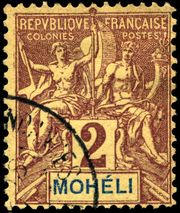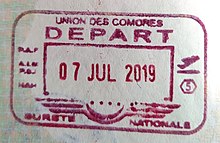Languages of the Comoros
[3] According to Harriet Joseph Ottenheimer, a professor of anthropology at Kansas State university, the linguistic diversity of the Comoros is the result of its rich history as part of the Indian maritime trade routes and its periods of Malagasy and French colonial rule.
[7] The Shingazija dialect is the most widely used variant of Comorian, spoken on Grande Comore (Ngazija) by about 312,000 people.
[9] In particular, both the government and the people of the Comoros sought for a writing system that was distinct from French, whilst resembling its nearby East African nations.
[2] According to Martin-Luther University professor Iain Walker, this debate has been largely avoided in Comorian politics, which has contributed to an increasing sociolinguistic disunity between the speakers of each variant.
According to a 2018 report by the Organisation Internationale de la Francophonie, 216,174 people, or 25.97% of the population, spoke French in the Comoros.
[2] French is considered the language of government and commerce and is acquired through formal, non-Qur’anic education.
[4] Internationally, the Comoros is recognised as a Francophone nation, and is a full member of the Organisation Internationale de la Francophonie.
During the colonial period, French was the main language of instruction across society, including administration, education and trade.
[4] Higher education is also dependent on French language ability, as many Comorian students attend universities in France.
Arabic functions as a liturgical language for the country's dominant religion, Islam, adhered to by 95% of the population.
[4][10] Arabic was first introduced as a result of increased Arabian maritime contact during the slave trade from the fifteenth to the nineteenth century.
[4] These influences had persisted with the spread of various Arabic publications such as Al Falaq in neighbouring Tanzania and the Comoros.
This is primarily due to the lasting importance of the Quranic School in the Comorian education system, existing in Comoros for more than four centuries.
[14] Six Arabo-Islamic colleges and an Institute for Arabic Language were constructed with financial support from the World Islamic League and Kuwait.
[18] Traces of Malagasy speakers predominantly reside in the islands of Mayotte and Moheli manifesting as small populations of Malagasy-speaking villages[6] The small Malagasy-speaking communities originated from the late 18th century to the early 19th century, with migrants from Madagascar settling in the Comoros.
[3] Historically, Swahili served as the lingua franca of the Comoros, used for trade with the Arabic Peninsula, the East African Coast.
[4] Many ancient Comorian poems and songs written in Swahili detail key historical events such as the slave trade, and the various battles between the Sultans who once ruled the Comoros.
[2] This is because, during the French colonial period, Comorian language use was forbidden in schools as it was not considered a suitable medium of instruction.
[12] Amongst the different variants of Comorian, the Shingazidja is considered the most commonly used dialect, due to the population of Grande Comore Island being the largest in the archipelago.


